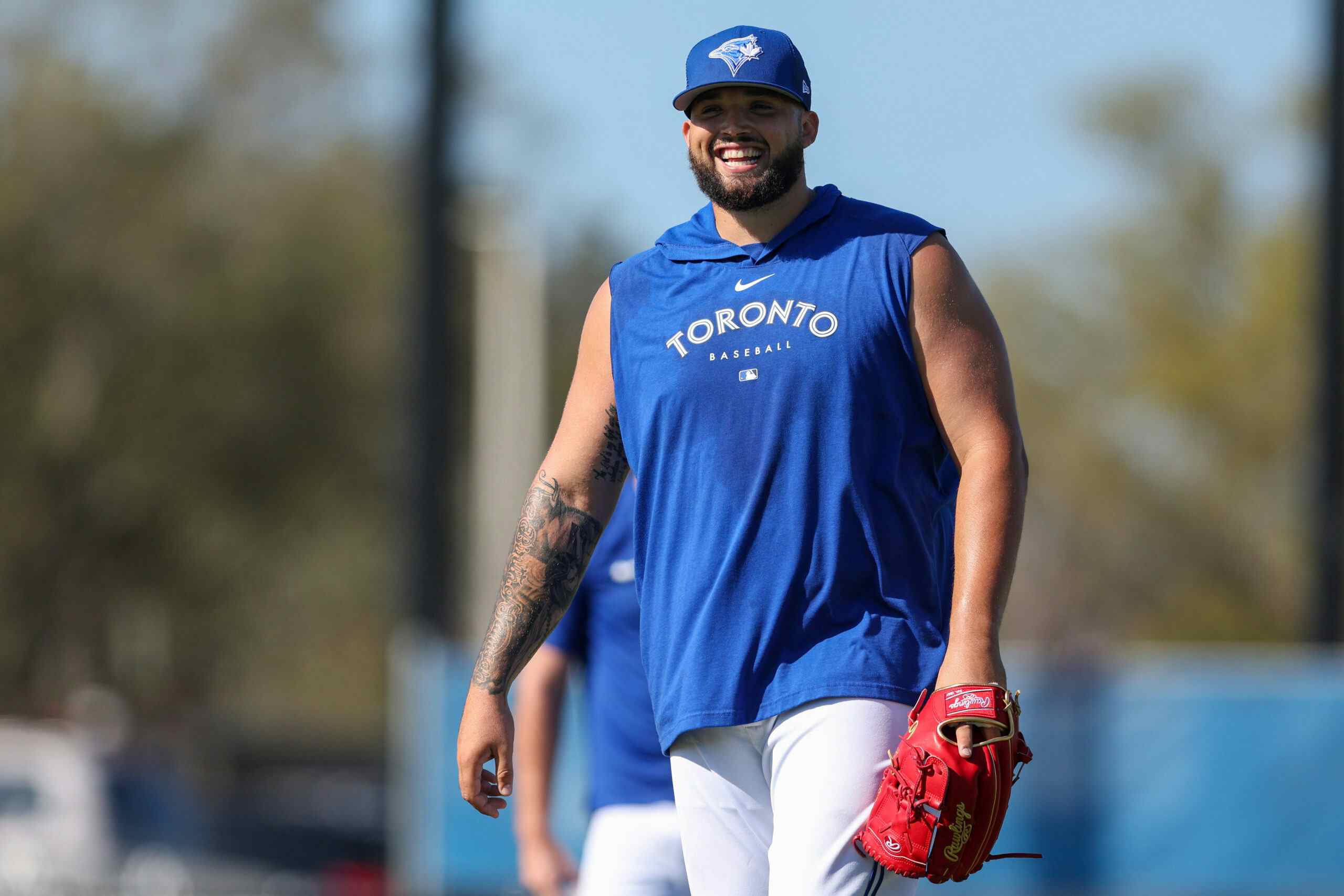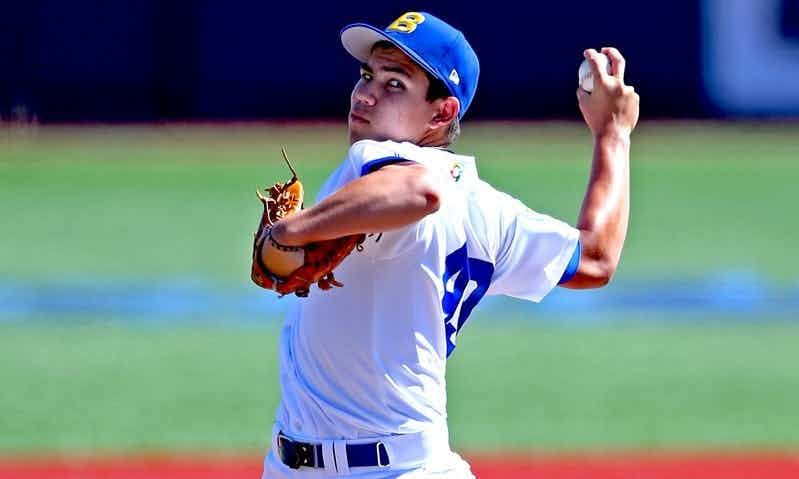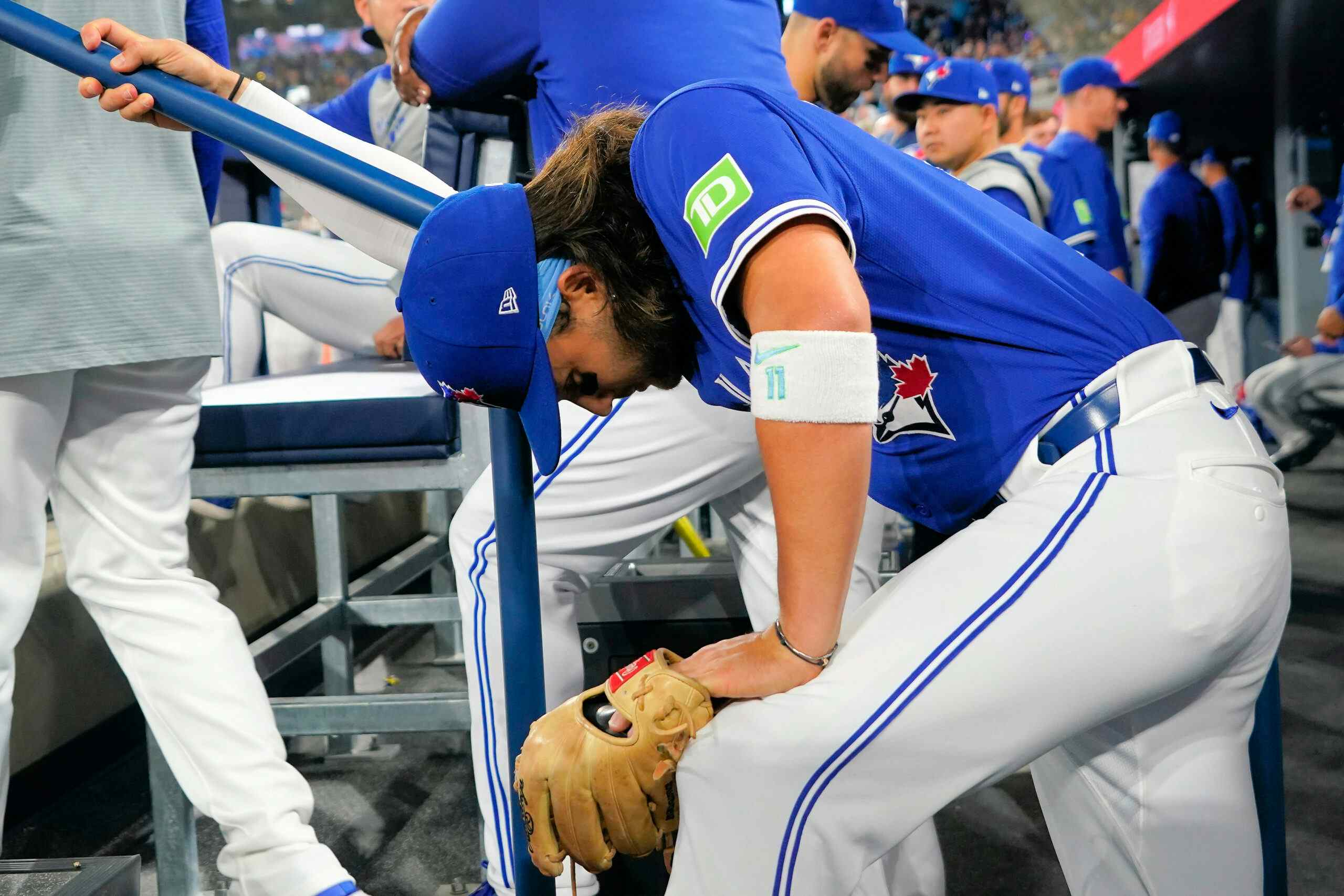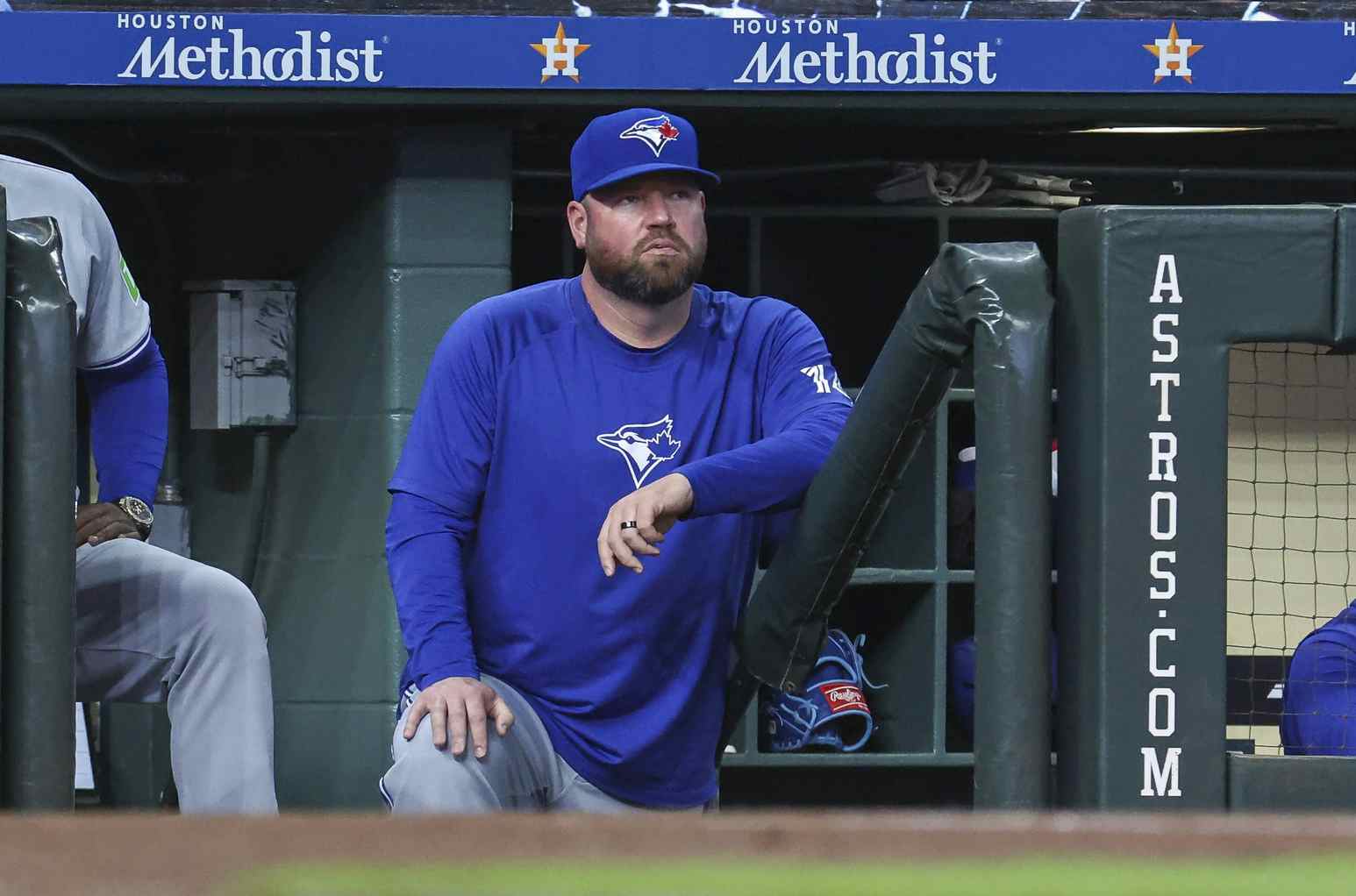Keith Law and Ross Atkins on Aaron Sanchez, the trade deadline, and more

Photo credit: Kim Klement-USA TODAY Sports
I feel like I should maybe write about R.A. Dickey, given that he was beaten up for a third straight start on Wednesday, and the knives are once again out. But the knives are always at the ready when it comes to Dickey, and he is what he is (and three starts ago had a 3.93 ERA), so I just don’t think it’s nearly as interesting as something else that’s been on my mind. And that’s Wednesday morning’s third hour of Naylor & Lansberg on TSN 1050 Radio in Toronto. (Audio here).
These days I’ve almost completely broken my sports talk radio addiction, so I must admit I haven’t listened to these guys very much, and I must say I quite liked the show — except when they both said that if they could choose any current Toronto athlete to keep in perpetuity they’d take Auston Matthews over Josh Donaldson, because LOLOLOLOLOLOL.
But it wasn’t so much the hosts that I found fascinating about this hour of programming, but the guests: namely, Keith Law and Ross Atkins.
Law spoke about the Jays’ recent deals, but especially hit the nail on the head when it comes to the Aaron Sanchez situation. And Atkins said as much as he could about that, and also had some interesting details about the impending trade deadline and his process this week.
Here are some highlights!
First up, Keith Law on Sanchez and the Verducci Effect:
This whole argument is based on a bad premise. Tom Verducci wrote a piece five or six years ago that claimed that pitchers who saw a big year-over-year increase in innings pitched got hurt. It turns out that it’s not true. Multiple people have studied this in depth. They’ve done a better job of dealing with data — the actual data — than Verducci did, because he was just looking at anecdotal evidence. And they’ve said, “No, there is no such effect.” So, if that’s the argument here — and that does seem to be it; people keep saying to me, “well, he’s going to throw 80 more innings this year than he did last year” — know what? That effect isn’t true. So that’s a terrible reason to either, one, shut him down, or two, put him in the bullpen.Secondly, I also agree with what you said: pitching in the bullpen is not actually a rest.Relievers seem to get hurt as frequently as starters do, if not more often. So, unless you’re going to put Sanchez in the bullpen and tell him, “Well, you’re only pitching every three days — we’re not going to use you on back-to-back days like we do most relievers,” I don’t see how that’s any kind of solution.What I think the Jays need to do is just watch him. If he’s showing signs of fatigue, then you take action. But if you watched his last start, the guy looks fine.. . .This idea of the innings jump year over year is still a fairly new one. Look, I’m all very much in favour of anything that keeps pitchers healthy. The problem is, we’ve looked at this and not found the evidence to support it. So, if it’s not going to keep pitchers healthy, let them keep pitching until their bodies or their mouths tell you, “I’m tired.” If Sanchez comes in and says, “Guys, it doesn’t feel right,” great, then at that point he’s done the right thing, then you take action. But simply deciding on some arbitrary innings limit, and saying, “Well, we’re just going to shut you down because ‘numbers,’” I’m not in favour of that.
This is beautiful, bang on stuff right here. Russell Carleton of Baseball Prospectus blew up the Verducci Effect like so many shredded arm tendons back in 2013, though there were previous studies (linked in his piece) that had come to similar conclusions — as did a 2012 Deadspin piece that asserted “its continued popularity has little to do with the power of numbers to support rational observation and everything to do with their power to baselessly reinforce existing beliefs.”
None of which is to say that pitchers can’t be overworked, obviously, or that young pitchers with large inning increases from one year to the next don’t sometimes get hurt. It’s just… they’re pitchers. Pitchers get hurt. Sanchez may end up getting hurt next year, even if they shut him down or dial him back. He might be entirely fine if they don’t — especially if they’re smart about it.
Hey, but are they actually going to be smart about it? Let’s see what Ross Atkins had to say about that (before we move on to the trade deadline and other stuff):
Both [moving him to the bullpen or having him in the rotation] are options. You can’t imagine the amount of creative solutions people are coming up with — and some of them are external; we’re saying, “wow, we didn’t even think of that angle.” Other teams that are calling us, and just talk shows — there are so many scenarios and ideas that are getting tossed around. It’s a great situation, really. Bodes really well for his future either way.
Asked more directly about the odds that he would be shut down at some point this season purely based on an innings target, Atkins replied:
That’s a good question. Sliding scale — depends on the number. Like I’ve said before, we don’t have a good number. I think those odds are slim, and that’s what we’re trying to accomplish. We have a great window right now, with a very good team, and he is a very good part of it. So how we can keep him a part of us if we’re pitching in Game Seven of the World Series is our goal.
And as for whether they can move him to the bullpen and actually make it less taxing on his arm?
I think if you manage it appropriately — which Gibby absolutely can and will and is very good at — and the fact that we are, at this point in the season, where we’re nearing September, where you can bolster your roster with a little more flexibility, you can do that. You can do it in a way where it’s not quite as erratic or demanding as it would be in May. But at the same time, there’s a lot of upside and a lot of benefit to keeping him on a five-day rotation, starting him and managing him — and maybe it’s not a five day rotation, but managing him as a starter in a more conservative way.
In other words, not a whole hell of a lot has changed — but on the bright side, he’s at least not repeating Gibbers’ “It’s gonna happen” line about Sanchez being sent to the bullpen.
I think everything’s a possibility. We want to get to the deadline and see how we make our team better — how does that play into it? But at the same time we have to stay open-minded and be flexible. It’s very similar to the situation we were in in spring training — we stayed flexible and we benefited from that big time. More thanks to Aaron Sanchez than anybody else, but the fact that we were open to starting him coming off of a year when he was an elite reliever, adding Drew Storen gave us the confidence to do that, and now we’re in the situation that we’re in, and we’ll take it.
Those may sound like hollow words, except that Atkins was clear that the team is looking for pitching — two pitchers, if possible — and are being particularly aggressive:
I can’t imagine being more active. It didn’t stop last night until 1 in the morning, and at 7 in the morning you’re already talking or either texting with other GMs. So, I can’t imagine being more active. So, whether that turns into a significant pitching piece for our team is going to be determined on really what the asking prices are and what we’re willing to give up. But I think that’s where we’re focussed now — is the best arm or two that we can get that complements our team.. . .The teams that are either clearly buying or clearly selling are more aggressive, on phone calls and on the text messages, and teams that are in the middle are either fielding or waiting to see how their team is going to play out. It’s been crystal clear for us, so we have been very aggressive, and extremely creative. We’ve incorporated at least 50 people in the organization to fill out surveys, questionnaires, come up with creative ideas, and then reach out to their contacts. And then we’ve kept that in a systematic way, where it doesn’t stop — so we’re foster as much creativity and as much communication as possible. So there may be teams calling more than us, but I think it would be hard.
That’s certainly a window into the process that we wouldn’t have gotten from the previous general manager here. Which doesn’t have anything to do with his ability to make his team better, but was interesting nonetheless. As was that fact that Atkins brought up the importance of player development in what I think was the simplest distillation of that philosophy — that concept that John Farrell once told us eluded Alex Anthopoulos — and why it’s so vital:
I think the most important thing that we can possibly do — certainly acquisitions and trades are significant and have a huge impact, but maybe what gets lost right now a little bit in the shuffle is focusing on improvement, and focusing on players getting better, and not so much on just assets. So we will spend an enormous amount of time, and pour an enormous amount of resources into development. And that’s at the Major League level, that’s all the way through the minor leagues, that’s for our staff, that’s for everyone. We’ve got to improve the pieces we have, is the best thing we can do.
That’s not to say that the Blue Jays under Anthopoulos didn’t try to make the pieces that they had better, obviously, but their minor leaguers were unquestionably viewed as trade assets, and often as chips to be parlayed into something to help the big club, rather than assets to the Blue Jays that it was necessary to get the very most out of. At least publicly — again, I’m certainly not saying that the Anthopoulos Jays ignored development, I’m just saying it’s maybe a little telling that the new regime so clearly focuses on it.
So.. yeah. That all sounds pretty good, I think.
But, of course, we’ll probably want to see what happens between now and Monday’s 4 PM ET deadline before we get too enamored with the job Atkins is doing just yet.
Recent articles from Andrew Stoeten





